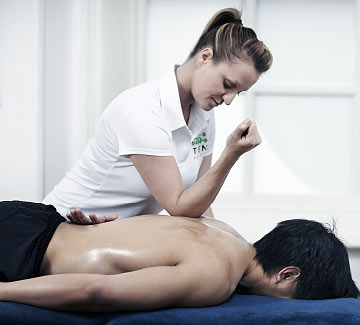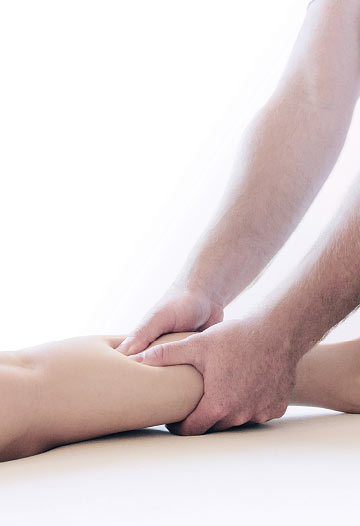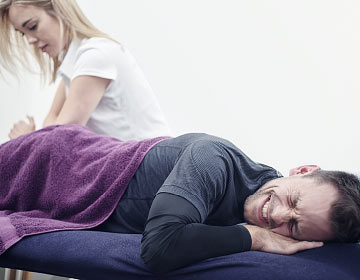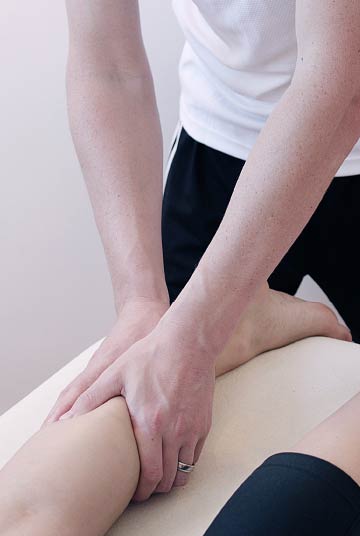
Why Get a Sports Massage?
If you play sports or exercise regularly, any serious athlete or Physio will tell you that you need to be combining your fitness routine with regular Sports Massage.
Regular massages will reduce your risk of injury, improve your recovery time post-workout, enable you to exercise more frequently, and make sure any little tweaks or niggles don’t turn into something bigger and nastier.
Call Studio Book appointmentIs Sports Massage Right for Me?
The name Sports Massage defines an overall approach to massage therapy, rather than something that's exclusively for sportsmen and women. Though it has been primarily designed to help improve performance and reduce pain and injury in sport, fitness and exercise, its results-driven approach makes it highly effective for people from all walks of life, particularly for anyone looking to improve flexibility, ease tight or painful muscles or combat postural or musculoskeletal pain – whether from an every day injury or simply (and frequently) from spending long hours at a desk.
Sports Massage techniques can also be used to reduce the impact of previous injuries, and the resulting scar tissue or inelasticity that may be impacting on your body’s ability to heal or move properly.
At Ten Health and Fitness, we provide Sports Massage for everyone from runners, triathletes, tennis players, footballers, cricketers and golfers, to weekend warriors, busy mums and time-poor executives


What Is Sports Massage Like?
Sports Massage is not the relaxing, tranquil treatment that you’d find at any spa. Instead, it’s a sports therapy designed to improve quality of movement, boost recovery from injury or exercise and ease pain. It is administered by qualified professionals who have been rigorously trained in the musculoskeletal structure and anatomy of the human body.
Sports Massage Techniques
At Ten, we use a number of different Sports Massage techniques (or modalities), some of the most common include:
-
– Effleurage
A variety of stroking movements usually carried out with the palm of the hand and fingers. It can be used with varying pressure and speed according to the purpose and stage of the massage.
It is most commonly used at the start and finish of a session, and its purposes are to relax the client, warm the tissues, relax the muscles, allow the therapist to sense the condition of the muscles and tissues, stimulate the nerves and increase lymph and blood flow.
-
– Petrissage
The basic Petrissage movement is a ‘kneading’ movement designed to compress and then release the soft tissue, using either direct pressure or by picking up and squeezing the skin and muscle.
It is is generally used to have a deeper effect on soft tissue than Effleurage, and includes kneading, squeezing, and other loosening techniques. The benefits of Petrissage include increased mobility between tissue layers, stretching of muscle fibres, muscle relaxation, improving blood and lymphatic flow and aiding with the removal of waste products.
-
– Myofascial release
A repetitive technique designed to stretch, loosen, soften and lengthen muscle tissue. Strokes are applied with gentle pressure along the muscle fibre and held for a short period of time to fully stretch the muscle, then repeated until the muscle is entirely relaxed.
Myofascial release is designed to free up fascia that may be impeding on blood vessels or nerves and improve circulation and nervous system transmission. Results include a decrease in muscle tightness, increased range of motion and reduction in pain in the affected area.
-
– Deep Tissue Massage
Relieves chronic tension of soft tissue, and can improve flexibility, range of motion and posture. As the name suggests, the focus is on the deepest layers of muscle tissue, tendons and the fascia (the protective layer surrounding muscles and joints). Despite what many people believe, Deep Tissue Massage does not need to be painful, although firmer pressure is often needed to encourage tight areas to release.
-
– Trigger Point techniques
Usually applied to particularly aggravated areas, often where there is referred pain or tenderness, trigger point therapy can eliminate pain and re-educate the muscles into pain-free habits. A long-term treatment, after a few sessions it can reduce swelling, stiffness and tension to improve circulation, flexibility and co-ordination. Counter-intuitively, while this technique can be uncomfortable, it can simultaneously feel good and will clearly highlight the source of the discomfort.
-
– Deep Friction Massage
This technique can be used as an alternative to trigger point pressure. Rather than a single point of pressure on the affected area, firm strokes are applied across the grain of the muscle to provide pain relief to increase blood flow, promote healing and reduce pain. Deep friction massage can also be used to break up scar tissue.
-
– Muscle Energy techniques
This technique lengthens shortened or spasmed muscles, strengthens weakened ligaments and muscle, and increases range of motion. The client will be asked to contract the muscle for a few seconds against an anti-force applied by the therapist, stretching the muscle. This is then repeated a number of times to apply the full effect of the technique to the muscle.
Your Massage Therapist will generally use several of these techniques at different stages of a massage to provide the best treatment for you. As a result, the selection and order of these techniques will vary from client to client and massage to massage.

Results & Benefits of Sports Massage
So, what does a Sports Massage do?
Sports Massage helps to combat the effects of injury and negative effect of intense and/or frequent sports or fitness training.
It eases tight or sore muscles and improves joint mobility, helping the body move better and recover from exercise faster. It accelerates healing of soft tissue injuries by encouraging the flow of blood carrying oxygen and nutrients, and by treating the muscle tightness and inelasticity that can hinder blood flow.
It can also improve posture, and help address the musculoskeletal impact of today’s sedentary and deskbound working practices.
Lastly, in addition to its physical effects, Sports Massage Therapy can also reduce stress and anxiety, improve mental and physical relaxation and promote a greater sense of well-being.
Call Studio Book appointment
